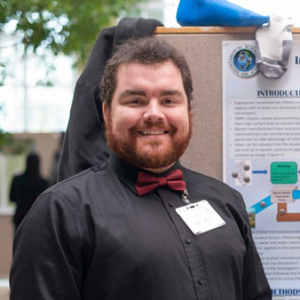
David Patch
Ph.D. Candidate
Chemistry & Chemical Engineering
The Royal Military College of Canada
2019 - Present
Supervisor(s): Kela Weber
Research Project: Release of Silver Nanoparticles from Commercial Products into the Water Cycle
Emerging contaminants (EC) are compounds found in the environment that are growing as a source of possible concern due to increases in concentration, unknown impact to human/environmental health, and complexities surrounding their transport potential. As commercial manufacturers incorporate new materials into their products there exists the potential for the release of EC through mechanisms of use and weathering of the products. Current methods often analyze bulk concentrations of a species present in the commercial product with little focus on the mechanisms of release common in active use scenarios. Understanding the mechanism of release is important because these mechanisms are often responsible for transformations to the contaminant, altering its transport and toxicity potential.
The emerging EC of concern for this project are silver nanoparticles. Ionic silver has been studied in the past for their release directly into the environment (from photographic waste) but the unique properties of nanoparticles and their incorporation into commercial products represents an area of concern due to potential for direct exposure to humans, release into the water cycle, and potential for transformation into other species. Silver nanoparticles have been found in common commercial products including clothing, food packaging, medical devices, sprays, and manufacturing materials and is often incorporated to inhibit bacterial growth. There currently exists no methodology to release and characterize silver nanomaterials being released from commercial products during active use scenarios. This research is to develop weathering methods capable of simulating physical and chemical conditions that silver-coated clothing undergo during their active use, which in turn will release silver nanomaterials characteristically similar to those released by human use. These released materials will then be examined the toxicity of these particles in wetland mesocosm systems.
Gray DB, Gagnon V, Button M, Farooq AJ, Patch DJ, Wallace SJ, Koch I, O'Carroll D, Weber KP. (2021) Silver nanomaterials released from commercial textiles have minimal impacts on soil microbial communities at environmentally relevant concentrations. Science of the Total Environment, 806(Pt 3):151248.
O’Carroll DM, Jeffries TC, Lee M, Le ST, Yeung A, Allace S, Battye N, Patch D, Manefield MJ, Weber KP*. (2019) Developing a roadmap to determine per- and polyfluoroalkyl substances-microbial population interactions. Science of the Total Environment, 712: 135994.
Di Battista V, Rowe RK, Patch D, Weber KP. (2020) PFOA and PFOS diffusion through LLDPE and LLDPE coextruded with EVOH at 22 °C, 35 °C, and 50 °C. Waste Management, 117: 93-103.
Turner LP, Kueper B, Jaansalu KM, Patch D, Battye N, El-Sharnouby O, Mumford K, Weber KP. (2020) Mechanochemical remediation of perfluorooctanesulfonic acid (PFOS) and perfluorooctanoic acid (PFOA) amended sand and aqueous film-forming foam (AFFF) impacted soil by planetary ball milling. Science of The Total Environment, 765: 142722.
Duchesne AL, Brown J, Patch D, Major D, Weber KP, Gerhard JI. (2020) Remediation of PFAS-Contaminated Soil and Granular Activated Carbon by Smoldering Combustion. Environmental Science and Technology, 54(19): 12631–12640.